Luang Prabang, Laos
How many people have heard of Luang Prabang?
Our plan was to find a quiet getaway location to spend the Christmas time, a peak travel time for tourists. We didn’t want to be in big city, and our extended visa was up in Thailand so we decided to fly to… Luang Prabang — a city, I knew absolutely nothing about, in a country I knew next to nothing, Laos.
If you looked at a map you can see it’s nestled snugly in the green mountains of northern Laos, not really close to anything except that it’s positioned on a winding bend of the wide Mekong River. Luang Prabang is a small city (55,000 people), and it’s a little surprising that it has an international airport. It does have some interesting history — important in World War II, and during the Laotian Civil War it was the royal capital. On the surface, all that seemed far in the past, strolling down the quiet streets we saw many hammer and sickle flags flying boldly and proudly.
Laos has about half the area of Thailand, and a tenth of the population. The 7 million people in Laos, compare to about half of the metro area population of Bangkok. But in Laos, only 53% identify as ethnically Lao — and that’s a hint that to the history…
The English word “Laos” was coined by the French, who united the three Lao kingdoms in French Indochina in 1893 and named the country as the plural of the dominant and most common ethnic group, which are the Lao people.
If you are in Luang Prabang it is worth visiting the Traditional Arts & Ethnology Centre which has some explanation of the different ethnicities showcasing the variety of clothing and accessories used to symbolize their lineage and cultural traditions.
 Panorama of Luang Prabang, looking west
Panorama of Luang Prabang, looking west
Hmong New Year
One day in town we met an Australian shop owner in town who suggested we check out the Hmong New Year celebrations which happened to be occurring during our stay. Finding the festival was a challenge because nobody could explain exactly where it was, they just said go behind the airport and follow where everyone is headed. So past a long dusty road past the airport we followed the pickup trucks, tuk tuks and motorbikes to a wooded area which you might call a forest except it was packed with thousands of people, hundreds of food stalls and miscellaneous vendors, smoke filled the air from a range of grilled foods, and loud music flooded the whole area.
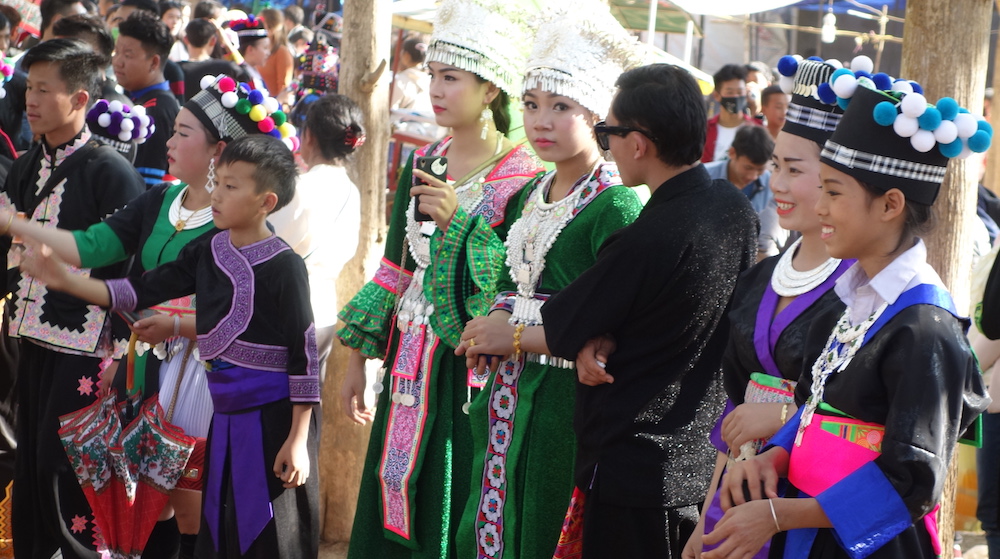 Hmong New Year crowd
Hmong New Year crowd
It was overwhelming at first, taking in the sight of all of these people — we were basically crashing their party. The New Year festival has many important aspects in the Hmong tradition, but the most visible is that it’s a time when people spend some of their saved up money to buy the nicest clothes for their children — a fusion of traditional and contemporary styles. A time to take pictures and show pride in their Hmong heritage. We saw several stalls devoted to taking family pictures with traditional clothes in front of mockups of mountain scenery.
The older children who are ready for the trials of courtship, participate in the “pov pob”, a game involving a ball being tossed between lines of participants with several rules involving the singing of love songs.
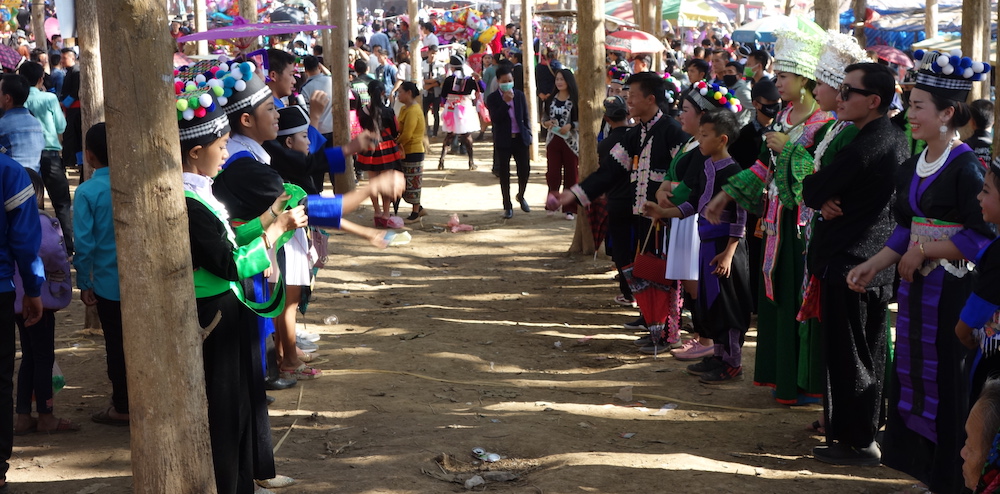 pov pob players
pov pob players
Monks
The town of Luang Prabang is dense with historical temples preserved in large part because of its vibrant monastic community. I’ve read that nearly a third of male Laotian children spend some time as novice monks, mainly as the best available option to get an education, especially for rural children. Many boys start as young as 8, or in some cases even younger. We saw these novice monks everywhere in town — strolling the streets, running errands or doing chores within their assigned temple grounds. Some were eager to chat in English, and spoke quite well.
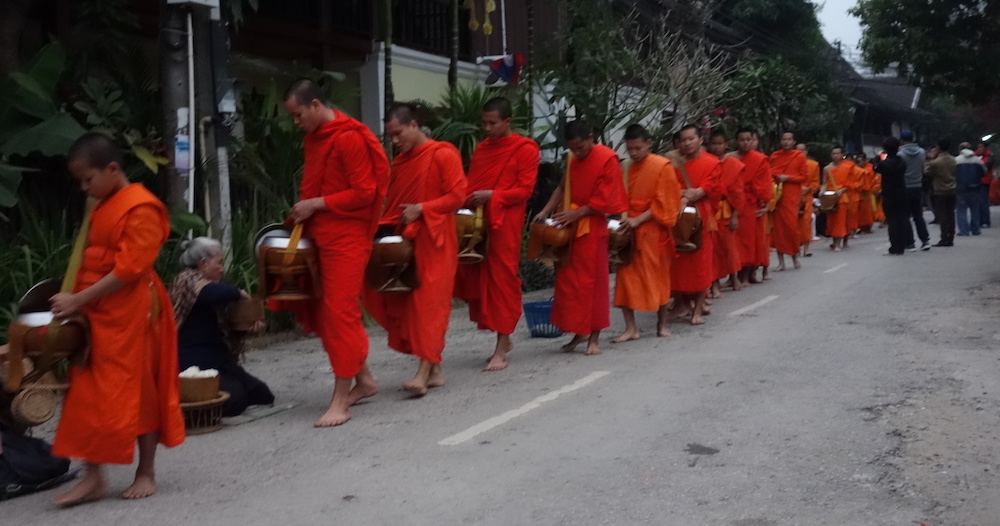 Morning alms ritual
Morning alms ritual
The ritual of the morning offering is carried out in many places across Asia with dense traditional Buddhist populations, and in Luang Prabang it is a spectacle that attracts many people. Monks rise early before dawn and take to the streets to silently and humbly receive offerings of food. In Laos these offerings are mainly chunks of sticky rice which are carefully tossed into the monk’s alms bowls by low-seated almgivers. I saw busloads of drowsy tourists stumbling down to the intersections led by smiling guides snapping pictures of these serious-looking young boys, some sitting at the low plastic seats to participate in the ritual.
Crafts village
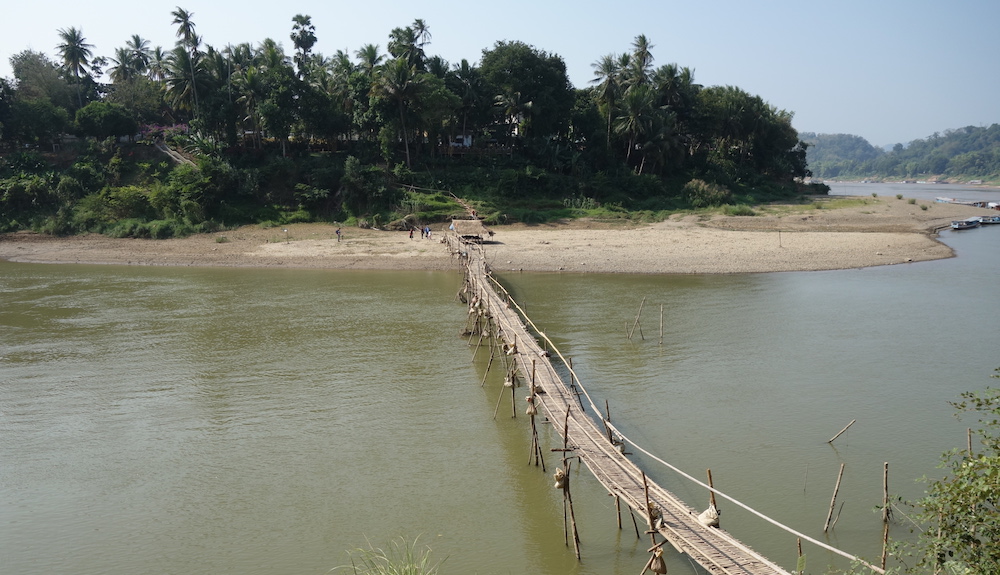 Bamboo bridge over Nam Khan river
Bamboo bridge over Nam Khan river
The center of Luang Prabang is actually a peninsula with the Mekong on one side and a smaller river, Nam Khan, wrapping around the other side. Each year the communities build a bamboo bridge to cross the river, connecting the town to the small villages on the other side. During the rainy season, the Mekong rises and overtakes the bridge to wash it away. The small villages on the other side are known for their paper making and silk weaving crafts. Along the simple dirt road we could see decorative paper in moulds drying in the hot sun. There were also small shops with weavers at looms, and selling truly beautiful items.
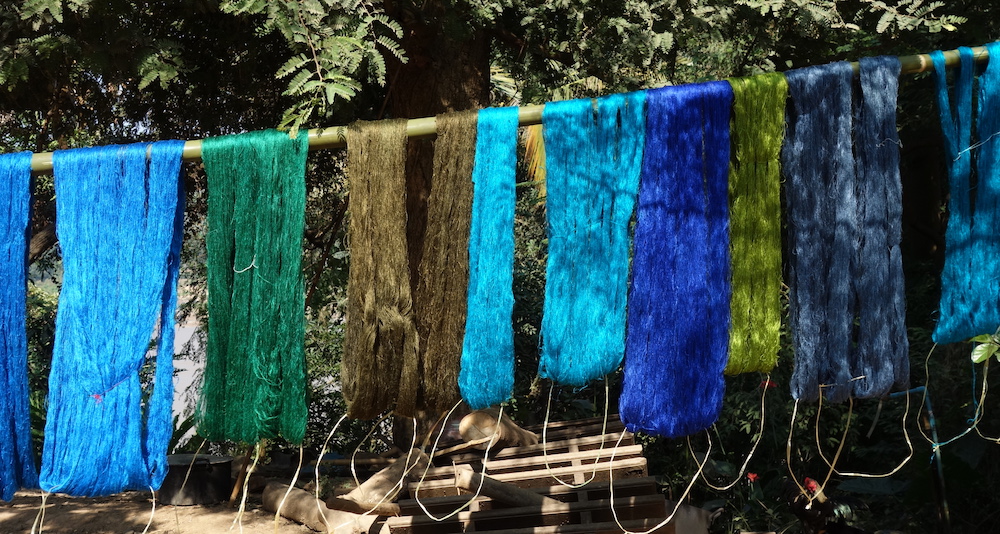 Silk thread, spun and dyed
Silk thread, spun and dyed
It was impressive to see and made me rethink some preconceived notions. When walking into shops in the U.S. lined with silk scarves with a small tag saying made in Laos, I had the vision of a worst case scenario, all these scarves being made in some poorly ventilated sweatshop basement, child labor exploited by oppressive heartless bosses. The picture that replaced that vision was not glamourous nor at all easy, but it was not (apparently) exploitative.
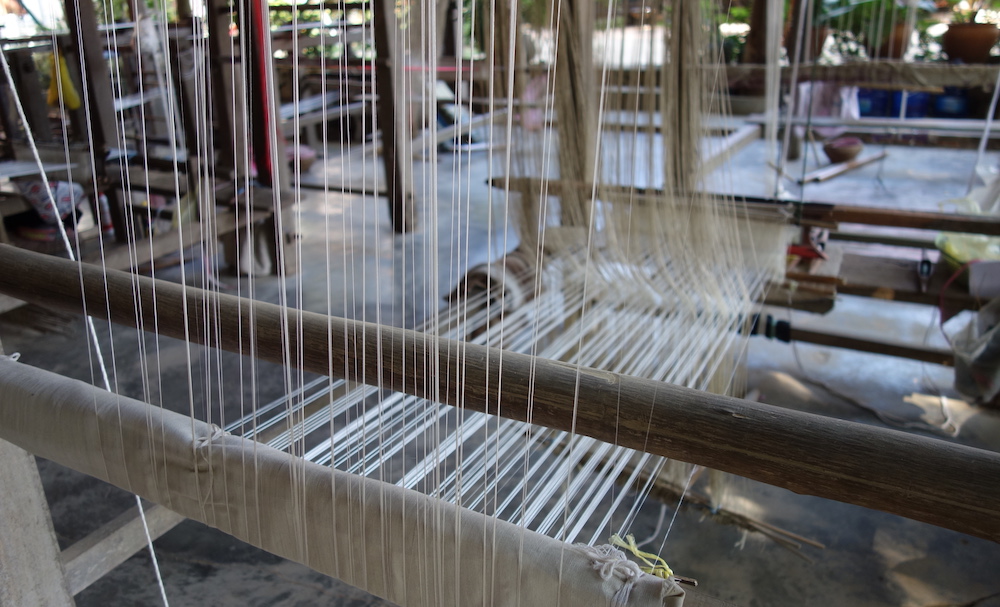 Looms for weaving silk and cotton
Looms for weaving silk and cotton
Money parade
We woke up a little late one morning and heard drumming and music from the street, so we strolled down from the upstairs room of our bed and breakfast to find a parade of thousands of people filing down the main street. They were of all ages and many were carrying … of specially fabricated money trees, that is a metal armature intricately adorned with bills (mostly bills of small value). These money trees were taken to be donated to Wat Xiengthong, one of the main temples of Luang Prabang. The money tree ritual is just one of the ways Buddhists “make merit” – to put it quite simply, merit is accumulated by doing good deeds which has the result of creating a protective and benefical force in the journey to enlightenment. Merit is related to karma but definitely not the same thing. After this experience I started to see money trees on display or tucked away inside other temples in Laos and Thailand.
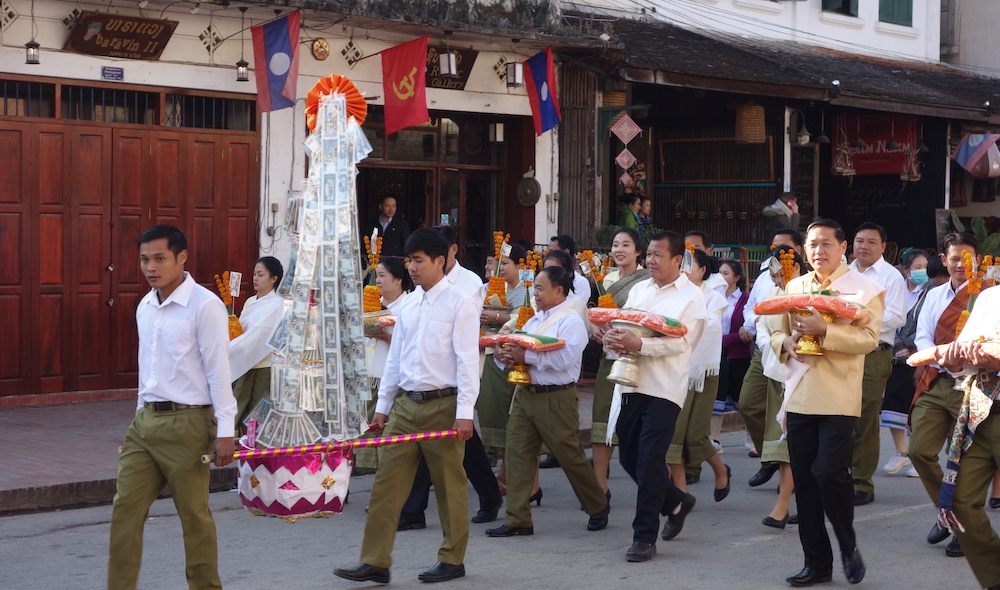 Money tree parade
Money tree parade
Kuang Si Waterfalls
Near the end of our stay we rode the motorbike south, made a short stop at a water buffalo farm for some buffalo milk ice cream, and then kept on to our destination: the famous Kuang Si Falls. Because the water pools over limestone deposits it gives the extensive run of falls a glowing and fantastical feeling. The afternoon sunlight beamed through the clear water bring out bright blues and greens. It was worth the ride. Along the hike up to the falls there was also a small set of exhibits of live Asian black bears. They looked playful but shy in their protected areas.
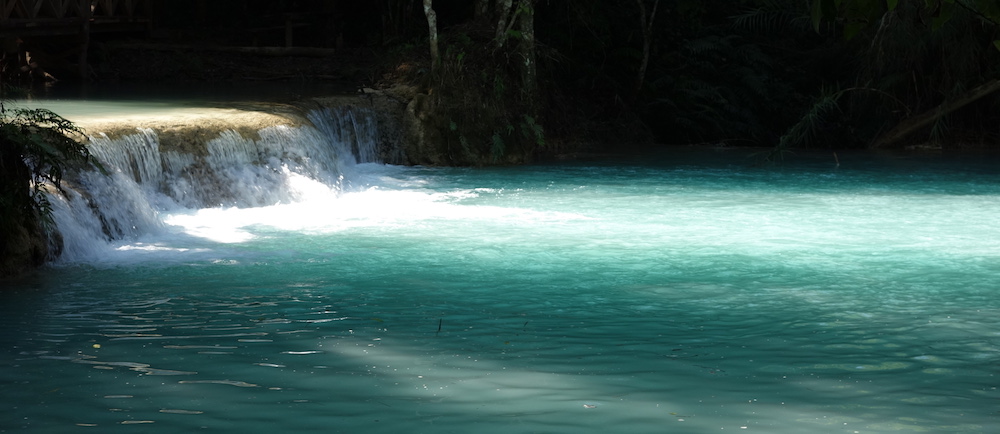 One of the pools of Kuang Si
One of the pools of Kuang Si
One random encounter then led us to another. Based on a tip from a couple Japanese ramen chefs in town, we stopped for dinner at Secret Pizza our way back from the falls. This place is tricky to find and only open 2-3 days a week, but otherwise it’s hardly a secret. It’s a big place and was packed with customers, some Chinese tourists flooded in by the busload. The pizza chef (an Italian expat) built his own brick oven and imports some authentic ingredients with mouthwatering results.
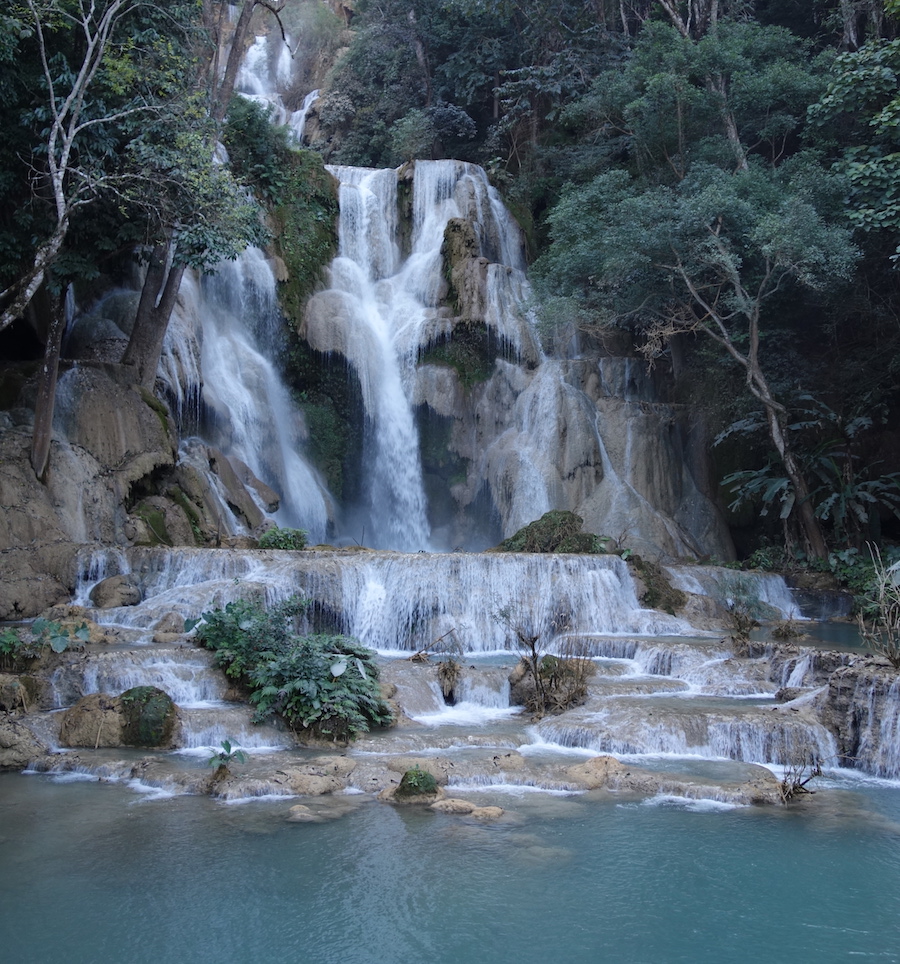 Main Kuang Si Falls
Main Kuang Si Falls